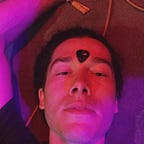Pranayama — the Yogic Origins of Western “Breathwork”
Much is said these days of “breathwork”
. . . and its amazing benefits for the mind and body. You may have come across techniques such as the Wim Hof Method, Holotropic Breathwork, and Rebirthing, or even practiced them for yourself.
Did you know, however, that all breathwork is derived from the Yogic practice of Pranayama? Initially, the concepts of this ancient system were diluted, branded, and detached from their origin in an effort to appeal to the Western market.
So what is Pranayama?
Let’s start with the word. In Sanskrit, “Prana” is a term that essentially means “universal life force energy.” That which animates all life. Call it chi, love, the holy spirit . . . whatever resonates with you.
As for the second half of the word, it’s a matter of interpretation.
In Sanskrit, “Yama” means restraint, control, or guidance. “Ayama” can be more broadly defined as to expand, lengthen, or stretch.
So if you mash it all up, you could say that Pranayama is a practice of guiding Prana into our system with the intention of expansion. Expanding what? Maybe our lungs. Maybe conscious awareness.
Notice that the focus here is not on the breath itself, but on Prana.
The aim of Pranayama is to harness this current of infinite energy. Through the breathing techniques of Pranayama, we invite this intelligent life force into our systems to purify and balance our energetic bodies, then to supercharge us.
The rishis (ancient mystics of India who dwelled in the forest and are said to have originally downloaded the source material for Vedanta, Yoga, Ayurveda, Hinduism, etc.) believed that Prana is carried into the body via the oxygen that we breathe. Therefore, we must utilize the breath as a vehicle for Prana and guide it through our system with specialized techniques.
But what about BREATH?
Maybe you’re not into the esoteric side of things. Did you know that Oxygen makes up only about 21% of the air we breathe? 78% of it is Nitrogen, and the other 1% is made up of other gasses.
On top of that, the average person only breathes to about 12% of their lung capacity (average adult lung capacity in males is about 6L; for females, it’s around 4.3L). That short, shallow breath that you’re probably experiencing subconsciously as you read this article is called “tidal breathing.” Tidal breathing brings in just enough Oxygen for your mind and body to function at a “standard” rate.
So if only 21% of each breath is nourishing Oxygen, and we tidal breathing only fills 12% of our lung capacity, you don’t have to be a mathematician to see how this is suboptimal.
Imagine a mango tree whose roots only drank enough water to survive. It would never flower. And it would certainly never bear fruit, which is its highest potential as an organism. Like this tree, we can only truly thrive to our human potential when we maximize our intake of air. And water! And healthy foods, exercise, etc.
In addition, the practice of Pranayama has been proven to yield benefits for the nervous system. Proper breathing and specialized techniques can help us reset our parasympathetic nervous system to get ourselves out of fight or flight feedback loops that arise due to daily stress.
Of course, breathwork and Pranayama both seek to bring about physiological and mental changes for the better. Breathing exercises and meditation are incredibly effective for reducing anxiety, addressing insomnia, moving through heavy emotions (and even traumas), and finding peace of mind.
However, most breathwork techniques or methods are singular in their focus, while Pranayama is a broad, all-encompassing system. Certain techniques can be applied for energizing the body and mind, while others are used to “cool” or balance the system. Pranayama practitioners also pay special attention to breath retentions, or “kumbakah” in Sanskrit.
Think of studying Pranayama as building a full tool kit for any purpose, whereas the breathwork approach is typically to apply one tool for multiple purposes.
Let’s shift ourselves away from the rational mind and head within.
Instead of reading about Pranayama and breathing exercises, try the Buddhist practice of Anapanasati for yourself. This is a breath focused meditation technique that was originally taught by the Buddha himself.
Ana (the inhale), Pana (the exhale), Sati (mindfulness)
In this practice, there is no special technique to learn or perfect. There is just single pointed awareness of the breath. As you breathe in, think to yourself “I am breathing in.” When you breathe out, say to yourself “I am breathing out.”
Bring your attention to the rise and fall of the chest.
Slow your breathing down. Inhale gently, exhale quietly.
Try to make each breath the same length.
Just feel and observe the body as you sit in quiet stillness.
Randall Head
. . . is a certified Pranayama facilitator, having completed his intensive training and comprehensive Vedic studies with The Breath Center in California in 2019.
He shares Pranayama and Sound Healing online (group, private, and corporate sessions) as well as in person at yoga studios, workshops, retreats, and festivals.
Randall also completed his 200 hour YTT in Sri Lanka during 2020.
For more information or to book a session, email wrhead91@gmail.com
